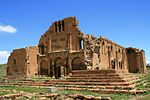The United Nations Educational, Scientific and Cultural Organization (UNESCO) designates World Heritage Sites of outstanding universal value to cultural or natural heritage which have been nominated by countries which are signatories to the UNESCO World Heritage Convention, established in 1972.[1] Cultural heritage consists of monuments (such as architectural works, monumental sculptures, or inscriptions), groups of buildings, and sites (including archaeological sites). Natural features (consisting of physical and biological formations), geological and physiographical formations (including habitats of threatened species of animals and plants), and natural sites which are important from the point of view of science, conservation or natural beauty, are defined as natural heritage.[2] Armenia ratified the convention on 5 September 1993.[3]
Armenia has three sites on the list, all of which are monasteries, churches, or related religious sites. The first property listed in Armenia was the Haghpat Monastery, in 1996. In 2000, the site was extended to include the Sanahin Monastery. In 2000, two further properties were added, the Cathedral and Churches of Echmiatsin together with the archaeological site of Zvartnots, and the Monastery of Geghard and the Upper Azat Valley. All three sites are of the cultural type. There are additional four sites on the tentative list.[3]
World Heritage Sites
UNESCO lists sites under ten criteria; each entry must meet at least one of the criteria. Criteria i through vi are cultural, and vii through x are natural.[4]
| Site | Image | Location | Year listed | UNESCO data | Description |
|---|---|---|---|---|---|
| Monasteries of Haghpat and Sanahin |  | Lori Province | 1996 | 777bis; ii, iv (cultural) | The monasteries of Haghpat and Sanahin were constructed in the second half of the 10th century under the patronage of Queen Khosrovanush, wife of King Ashot III. Additional buildings in both complexes were being added until the 13th century. Architecturally, the monasteries combine the features of Byzantine ecclesiastical architecture with the vernacular regional styles from the Caucasus. The Haghpat Monastery (pictured) was listed as a World Heritage Site in 1996, the Sanahin Monastery was added in 2000.[5][6] |
| Monastery of Geghard and the Upper Azat Valley |  | Kotayk Province | 2000 | 960; ii (cultural) | The Monastery of Geghard is located in the Azat River gorge. Saint Gregory the Illuminator founded the monastery in the 4th century, according to tradition. This coincided with the introduction of Christianity as the state religion in Armenia. The main complex dates to the 13th century. It includes rock-cut churches, tombs, residential cells, and several khachkars (Armenian memorial stele with decorated crosses). The monastery was an important ecclesial and cultural centre of medieval Armenia.[7] |
| Cathedral and Churches of Echmiatsin and the Archaeological Site of Zvartnots |  | Armavir Province | 2000 | 1011; ii, iii (cultural) | This site covers churches that illustrate the evolution and development of Armenian ecclesial architecture. Churches in Etchmiadzin (today called Vagharshapat) include the Etchmiadzin Cathedral (founded in 301, pictured), Saint Gayane Church (630), Saint Hripsime Church (618), and Shoghakat Church (built in 1694 upon a 4th century chapel). The Zvartnots Church was built in the 7th century but destroyed in the 10th century, possibly due to an earthquake.[8] |
Tentative list
In addition to the sites inscribed on the World Heritage list, member states can maintain a list of tentative sites that they may consider for nomination. Nominations for the World Heritage list are only accepted if the site has previously been listed on the tentative list.[9] Armenia has four such sites.[3]
| Site | Image | Location | Year listed | UNESCO criteria | Description |
|---|---|---|---|---|---|
| The archaeological site of the city of Dvin |  | Ararat Province | 1995 | ii, iii, vi (cultural) | King Khosrov III built a palace in Dvin in the 4th century, to serve as the capital of Armenia and the seat of Catholicos. During the Sasanian period and under the Caliphate, Dvin served as a regional capital. In the 13th century, it was destroyed by the Mongols.[10][11] |
| The basilica and archaeological site of Yererouk |  | Shirak Province | 1995 | iii, iv, vi (cultural) | The basilica was built in the 4th century CE and is one of the earliest Christian monuments in Armenia. It was damaged by an earthquake in the 17th century and is now a ruin.[12] |
| The monastery of Noravank and the upper Amaghou Valley |  | Vayots Dzor Province | 1995 | i, iii, vi, vii, ix (mixed) | The monastery dates to the 13th century and is located in a river gorge. Some buildings in the complex were designed by the architect Momik.[13] |
| The monasteries of Tatev and Tatevi Anapat and the adjacent areas of the Vorotan Valley |  | Syunik Province | 1995 | i, ii, iv, vi, vii, ix (mixed) | The monastery of Tatev, dating from the 9th to 13th centuries, lies above the Vorotan gorge, while the Tatevi Anapat monastery from the 17th century lies on the bottom of the valley. The gorge, with the depth of 850 metres (2,790 ft), is the deepest in Armenia.[14] |
| Vishaps and the Cultural Landscape of Tirinkatar |  | Aragatsotn Province | 2024 | ii, iii, vi (cultural) | In the high mountains of Armenia, unique archaeological monuments have been preserved to our days, which are traditionally called by the people “vishap” (Armenian for “dragon”). These are two to five meter high basalt stelae, which are unique among the stone stelae of the ancient world because of their unparalleled animal iconography and peculiar locations. Vishaps are either sculpted in the form of a fish (the piscis kind) or carved as if a bovine hide with head and extremities was draped over them (the vellus kind). Sometimes both iconographies are combined (the hybrida kind).[15] |
See also
References
External links

